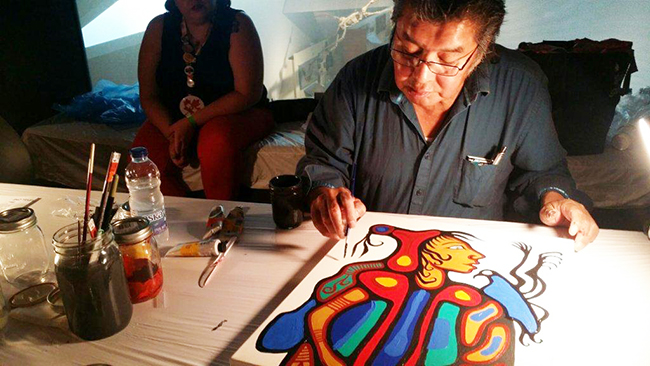Woodland School master painter at the ROM

By Barb Nahwegahbow
TORONTO – Visitors to the Royal Ontario Museum (ROM) were recently given the rare privilege of watching a Woodland School master painter at work. Saul Williams, a citizen of North Caribou Lake First Nation shared his techniques as part of the programming related to the exhibition, Anishinaabeg: Art & Power currently at the ROM. Williams is one of three curators for the exhibition that runs until November 19, 2017. One of his paintings, White Women and Their Plants, done in 1978 is in the show.
Not only is Williams a master painter, but he’s also a champion multi-tasker. He was working on 5 – 6 paintings, answering interview questions, chatting with the people watching and answering their questions. He was also telling the stories about the paintings he was working on. His brush stroke remained firm and steady with no hesitation. He enjoys what he’s doing and his audience didn’t distract him. Not even the little boy, so intrigued and attracted by all the bright colours on the canvas that he slapped his palms right on top of the wet painting. The parents were horrified and apologetic, but Williams remained gracious and unfazed by the smeared painting. “It’s okay, I can fix it,” he told the parents and he proceeded to do so. “Kids are like that,” he said laughing and told a story about waking up one day and finding his own children completely covered in paint.
He started the paintings with blocks of colour and then filled in the black lines around the people or animals or birds, and then the details. One painting becomes a bear, an important animal to First Nations he told his audience because bear has a lot of medicine. Another painting is The Beadworker that illustrates the importance of dreams. “Somebody tells them what their design is,” he said, and the bird sitting on the woman’s shoulder, “that’s the messenger, they talk to them and bring them stuff.” With a few magical brush strokes, he brings the subjects in his paintings to life.
He doesn’t always start the same way. Sometimes he draws on the canvas. Sometimes, he has a vision in his head, and at other times, he just starts painting. However he does it, Williams makes it look easy. “Well, I’ve been doing it for many years,” he explained.
“I sold my first painting to ROM for five dollars back in the 60’s and I thought it was a lot of money. Back in the 60’s, it was a lot of money.”
Arni Brownstone on staff at ROM and also one of the curators of the current exhibition, calls Williams a born storyteller, both visually and orally. Several days following Williams’ July 1st demonstration, Brownstone showed this writer Williams’ five dollar paintings, a series of five large works done with acrylic on kraft paper. They were done for Dr. Mary Black, a ROM linguist who was working in Williams’ community in the 1960’. She gave him his first painting supplies when he was 15 years old. The two Thunderbird paintings are especially striking with their detail and mix of colours, his technical skill, and the understanding of his subject matter that he demonstrated at such a young age. He’s a self-taught painter, and his works are based on the stories and legends he heard from his grandparents and other community elders. “That’s how people taught their kids,” he said, “and that’s why we’re visual learners.”
Williams lived in Toronto in the 1970’s and had his first show at York University. He’s always been an avid reader, reading about five novels a week. “That’s how I learned about the outside world,” he said, “and I didn’t have much of a problem being on the outside.” When Dr. Black took Williams and several of his friends on a trip to San Diego when he was fifteen, it was an adventure where he experienced many firsts, he said and it was like travelling through time. It was his first time being out of the community, flying, riding in a car and staying in a hotel and watching television. It was also the first time he wore pajamas. “I was the only one who knew what they were,” he recalls, “because I’d read a lot of books. One guy put pajamas right on top of his clothes. He looked like a Michelin Man!” He’s full of stories and he’s not afraid to laugh at himself.
For the last 30 years, Williams has worked full-time as the Education Director for his community, and “painting is more like a hobby,” he said. He thinks probably anyone can paint, “but people are not brave enough to try and that’s the problem. You have to be brave. You have to take a risk.”
Admission to the ROM is free for Indigenous persons.


